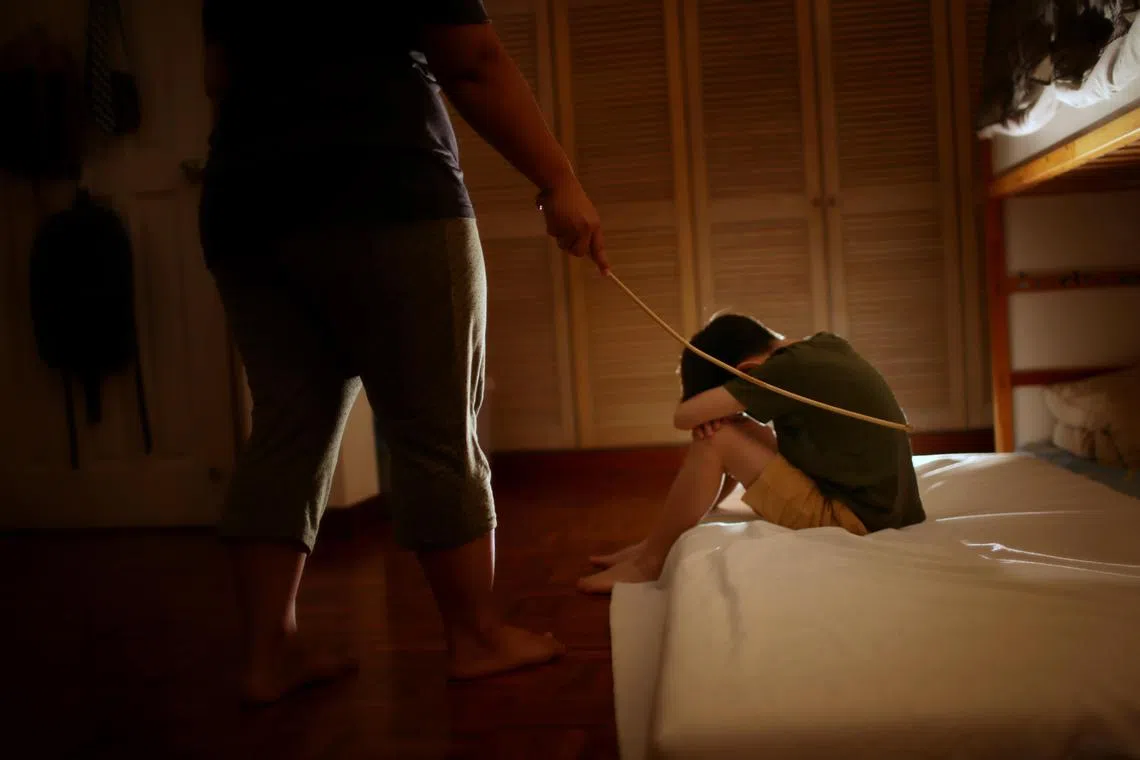Less serious child abuse cases in Singapore on the rise: Inaugural report on family violence
Sign up now: Get ST's newsletters delivered to your inbox

Greater awareness and reporting of family violence, coupled with better detection, are behind the growing number of cases.
PHOTO ILLUSTRATION: ST FILE
Follow topic:
SINGAPORE – The number of less serious child abuse cases has been on the rise in the past few years, and those in primary school form the largest group of children abused by a loved one.
The number of new Tier 1 child abuse cases, defined as those with low to moderate safety and risk concerns, rose 17 per cent from 2,377 cases in 2021 to 2,787 cases in 2023.
Greater awareness and reporting of family violence, coupled with better detection of such violence, are behind the growing number of cases, said the inaugural Domestic Violence Trends report released by the Ministry of Social and Family Development (MSF) on Sept 26.
The report provides an overview of key family violence trends – including spousal and elder abuse – in Singapore, based on cases overseen by the MSF and community agencies, such as child protection specialist centres and family service centres (FSCs).
Meanwhile, the number of new Tier 2 child abuse cases fell slightly from 2,141 cases in 2021 to 2,011 cases in 2023. Early detection and intervention by community agencies would have prevented cases from escalating in risk, said an MSF spokeswoman.
Tier 2 cases are high-risk cases that may warrant removing the child from the family to keep the child safe, and are managed by the MSF’s Child Protective Service, while Tier 1 cases are managed by community agencies.
In Tier 2 cases, children may have severe injuries such as burns or fractures inflicted on them by their parents.
For example, in a Tier 2 case managed by the MSF, a man and his 16-year-old son fought when the teen refused to show his phone to his father.
The son ended up with a broken nose and swelling in multiple parts of his body, and required medical treatment in hospital.
While the report gave data only from 2021 to 2023, it noted that the number of new Tier 2 cases rose 63 per cent from 1,313 cases in 2020 to 2,141 cases in 2021.
This could suggest that families faced more stress and conflict during the Covid-19 pandemic, while the Government stepped up campaigns to raise awareness of child abuse, said the report.
The 28-page report also showed the growing numbers of spousal violence and less serious elder abuse cases in the past few years.
Minister of State for Social and Family Development Sun Xueling said the number of child abuse cases is “concerning”.
She said the reasons for child abuse are multifaceted, including stressors relating to financial hardship or mental illness.
She pointed out that physical abuse is the most common type of abuse, and that some of the children were excessively punished by their parents.
She said: “We recognise the role parents play when it comes to disciplining their children, but there is a line to be drawn when that discipline becomes overly harsh and excessive.
“And this could be seen if there are open wounds and very prevalent marks of abuse on the child.”
In such cases, the Child Protective Service will investigate the case and let the courts decide on the matter, she said.
She added: “Very importantly, any form of discipline has to be proportionate to the behaviour of the child. So, excessive discipline that causes harm to the child is not something that we condone.”
Physical abuse the most common type of child abuse
In 2023, physical abuse was the most common primary type of abuse suffered by children in the new Tier 2 cases, followed by neglect.
Taking the third spot was emotional and psychological abuse, while sexual abuse was the least common form of abuse.
Ms Joyz Tan, director of Fei Yue Family Service Centre, said that neglect is defined as when the parent fails to provide for the child’s basic needs, such as shelter, food and care.
For example, a young child may be left unsupervised for a long period of time as his parents are busy working, and this could place the child in danger because of his age, she said.
A child may suffer more than one type of abuse, and the primary type of abuse refers to that which causes significant harm to the child, the report said.
More girls than boys were sexually abused in 2023.
Children from newborns to six-year-olds formed the largest group of new Tier 2 cases in 2023 as they tend to be more vulnerable, and more of these cases required the MSF to intervene to keep them safe, the report said.
However, for the less serious new Tier 1 cases, the largest group of abused children in 2023 were those aged between seven and 12.
Acting chief executive of Montfort Care Han Yah Yee said many Tier 1 cases involve harsh physical punishment.
This is when parents, for example, use items such as canes or belts to hit their children excessively, until there are scars and bruises, she said. Montfort Care is a social service agency that runs a child protection specialist centre and three FSCs.
“Parents don’t want to intentionally harm their children, but some are very stressed and their threshold for managing and disciplining their children is low,” she said, adding that stressors include finances, strained marital relationships, work and mental health woes.
“So, they choose physical punishment as they feel it works, and they don’t have the bandwidth to try other (discipline) methods.
“The punishment gets worse and worse, and they may lose control of themselves as they get so angry.”
An example of a Tier 1 case the MSF cited was that of a 14-year-old girl who ran away from home. Her father had caught her playing games and shouting vulgarities, and caned her until she had red marks all over her body.
The father said he had difficulty managing his daughter, as she would “act out” in school and at home. The man agreed to work with a child protection specialist centre to manage his daughter’s behaviour. He also stopped using physical punishment on her.
Social workers interviewed say that primary school children form the largest group of Tier 1 cases as they are better able than younger children to articulate their experiences. Many physical abuse cases are also spotted and reported by their teachers and counsellors.
More than 9,300 people in various sectors, including childcare staff and school teachers, have so far been trained to spot and report signs of family violence.
A spokesman for the Early Childhood Development Agency (ECDA) said that all ECDA-accredited training programmes for those joining the early childhood sector now cover how to detect and respond to potential cases of abuse, among other things.
In the past two years, there have been a few cases of children who were abused to death and whose cases were heard in court.
They include Ayeesha, a severely malnourished five-year-old girl who was confined in a toilet for 10 months
When asked what the MSF is doing to prevent such cases, Ms Sun noted that these cases happened before the Taskforce on Family Violence was set up in 2020 to address gaps and see what more could be done to boost protection and support for victims, among other areas.
A series of measures has since been implemented based on the task force’s recommendations, including the introduction of a 24-hour emergency response team made up of social service professionals who respond to high-risk domestic violence cases with the police.
The Domestic Violence Emergency Response Team (Dvert) responded to 307 cases from its launch in April 2023
When amendments to the Women’s Charter
The MSF spokeswoman said the ministry has beefed up its child protection protocols and strengthened coordination between government and community agencies to check on vulnerable children regularly.
The MSF had previously told ST
The enhanced protocols include beefing up the practice guide for FSC case workers to see, in person, vulnerable family members to ensure their safety and well-being, and ensuring regular safety checks and monitoring of abused children after they are discharged from alternative care and returned to their families.
Compared with other countries, the incidence rate of new Tier 2 child abuse cases remains low at 2.4 cases per 1,000 children in 2023.
The rate was 21 per 1,000 children in Australia from 2021 to 2022, the MSF spokeswoman noted.
The data in the report will serve as a common reference point for the MSF and community agencies to monitor domestic violence trends and guide their intervention efforts over time.
If you are or suspect someone is facing family violence, please call the National Anti-Violence and Sexual Harassment Helpline on 1800-777-0000.
Correction note: In an earlier version of the story, we said that Montfort Care runs four family service centres. This has been corrected to three family service centres.


